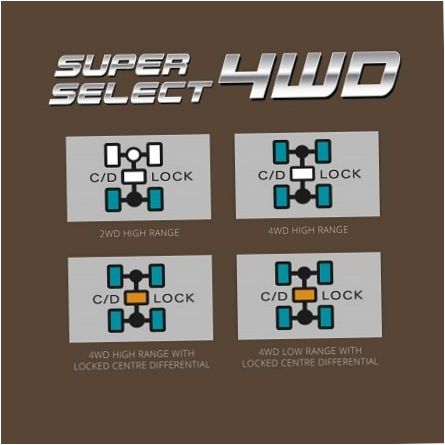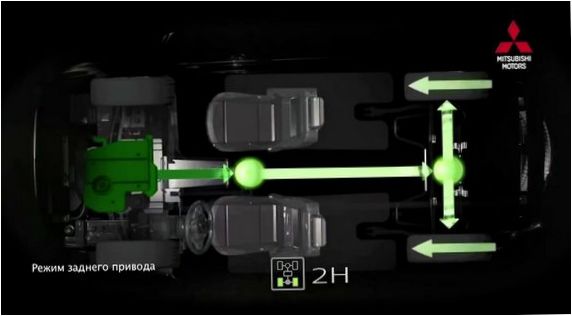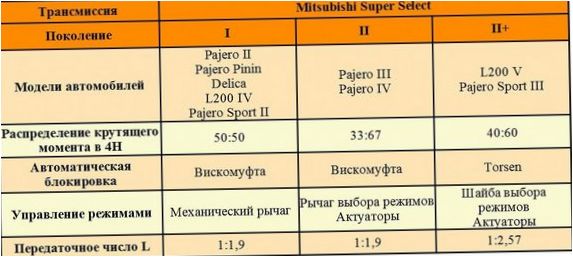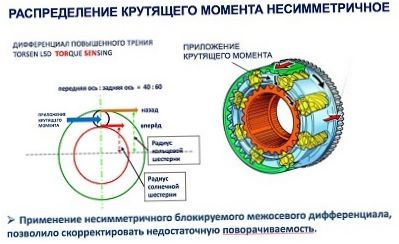
The device and principle of operation of the Super Select transmission
Content
Mitsubishi's Super Select transmission revolutionized the design of all-wheel drive systems in the early 1990s. The driver controls only one lever, but at the same time he has three transmission modes and a downshift.
Super Select Transmission Features
Transmission Super Select 4WD was first implemented in the Pajero model. The design of the system allowed the SUV to switch to the required driving mode at speeds up to 90 km / h:
- rear;
- four-wheel drive;
- four-wheel drive with a locked center differential;
- low gear (at speeds up to twenty km / h).

For the first time, a Super Select all-wheel drive transmission has been tested on a sport utility vehicle, an endurance test during the 24 Hours of Le Mans. After receiving high marks from experts, the system is included as standard on all SUVs and minibuses of the company.
The system instantly changes from mono to all-wheel drive on a slippery road. During off-road driving, the center differential is locked.
The low gear allows for a significant increase in the torque on the wheels.
Generations of the Super Select system
Since mass production in 1992, the transmission has undergone only one upgrade and update. Generations I and II are distinguished by slight changes in the design of the differential and the redistribution of torque. The upgraded Select 2+ system uses Torsen, replacing the viscous coupling.

The system consists of two main elements:
- transfer case for 3 modes;
- reduction gear or range multiplier in two stages.
Clutch synchronizers allow shifting directly on the move.
A feature of the transmission is that the viscous coupling regulates the operation of the differential only when the torque is distributed. When driving around the city, the node is inactive. The table below shows the use of Super Select in Mitsubishi vehicles:

How the system works
The first generation transmission uses a symmetrical bevel differential, the torque is transmitted by a sliding gear with synchronizers. Gear shifting is done by a lever.
The main features of "Super Select-1":
- mechanical lever;
- torque distribution between axles 50×50;
- downshift ratio: 1-1,9 (Hi-Low);
- use of viscous coupling 4H.
The second generation of the system received an asymmetric all-wheel drive, the torque ratio changed - 33:67 (in favor of the rear axle), while the Hi-Low downshift remained unchanged.

The system replaced the mechanical control lever with an electrically operated electric lever. By default, the transmission is set to drive mode 2H with a driven rear axle. When all-wheel drive is connected, the viscous coupling is responsible for the correct operation of the differential.
In 2015, the transmission design was improved. The viscous coupling was replaced by the Torsen differential, the system was called Super Select 4WD generation 2+. The system has an asymmetric differential that transmits power in a ratio of 40:60, and the gear ratio has also changed 1-2,56 Hi-Low.
To change the mode, the driver just needs to use the selector washer, there is no transfer case lever.
Super Select Functions
The all-wheel drive system has four main modes of operation and one additional mode of operation that allows the car to move on asphalt, mud and snow:
- 2H - rear wheel drive only. The most economical way used in the city on a regular road. In this mode, the center differential is fully unlocked.
- 4H - all-wheel drive with automatic locking. It is possible to switch to all-wheel drive at speeds up to 100 km / h from 2H mode by simply releasing the accelerator pedal and moving the lever or pressing the selector button. The 4H provides agility on any road while maintaining control. The differential locks automatically when wheel spin is detected on the rear axle.
- 4HLc - all-wheel drive with a hard lock. The mode is recommended for off-road and roads with minimal grip: mud, slippery slopes. 4HLc cannot be used in the city - the transmission is subject to critical loads.
- 4LLc - active downshift. It is used when it is necessary to transfer a large torque to the wheels. This mode should only be activated after the vehicle has come to a complete stop.
- R/D Lock is a special locking mode that allows you to simulate a rear cross-axle differential lock.
Advantages and disadvantages
The main advantage of the Mitsubishi transmission is a switchable all-wheel drive differential, which surpasses the famous Part-Time in practicality. It is possible to change driving modes without stopping. Using only rear-wheel drive significantly reduces fuel consumption. According to the manufacturer, the difference in fuel consumption is about 2 liters per 100 kilometers.
Additional benefits of the transmission:
- the possibility of using all-wheel drive for an unlimited time;
- ease of use;
- universality;
- reliability.
Despite the obvious advantages, the Japanese all-wheel drive system has one serious drawback - the high cost of repairs.
Differences from Easy Select
The Easy Select gearbox is often referred to as the light version of the Super Select. The main feature is that the system uses a rigid connection to the front axle without a central differential. Based on this, the four-wheel drive is switched on manually only when necessary.

Do not drive an Easy Select vehicle with XNUMXWD on all the time. Transmission units are not designed for permanent loads.
It should be noted that although Super Select remains one of the most versatile and simple all-wheel drive systems. There are already several sophisticated electronically controlled options, but they are all significantly more expensive.
